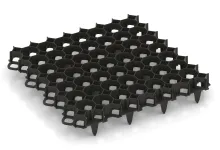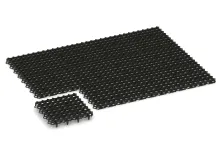Rubber paving TZ "Light Granite"
- /
-
Delivery in approx.
7-14 days - £76.40 / 4 Piece / m²
- (7.85 kg / Piece)
EAN: 4251469328785 | Item no.: 2878
A path made with WARCO rubber paving is pleasantly resilient, quiet and safe to walk on. The surface cushions each step, reduces impact noise and provides a comfortable, natural walking experience – almost like walking on forest floor. The paving is fully permeable: rainwater drains freely through the surface into the ground, keeping the path dry and slip-resistant even in wet weather.
Full-depth interlocking connection
Each tile features a full-depth interlocking puzzle profile around all four sides. This design creates a secure, form-fitting connection that keeps the tiles firmly linked across the surface. The symmetrical interlock allows any side to connect with any other, simplifying installation and ensuring clean, consistent joints. The tiles can also be lifted and reused without damage.
Elastic surface with functional benefits
The resilient paving structure offers excellent walking comfort and significantly reduces rolling or impact noise from hard footwear, skateboards or trolleys. The surface also provides fall protection – a clear benefit for children, older people or rehabilitation areas. The textured finish remains reliably non-slip in both wet and dry conditions. The paving is strong enough to handle light vehicle traffic, provided the base is prepared correctly.
Formats and installation
Rubber paving is available in a 50 × 50 cm format and in four thicknesses – 3, 4, 5 or 6 cm. Thicker tiles offer higher stability but slightly reduce water drainage. Installation is straightforward: the tiles are laid loosely on a compacted, stable base, ideally using gravel grids or lawn grids. They can be easily cut to size with a jigsaw or circular saw, allowing straight, curved or branching paths to be created precisely. In most cases, edging stones are not required when laid flush with the surrounding ground.
Durable and low-maintenance
Made from PU-bound ELT rubber granulate, the tiles are available in several attractive colours. The surface requires very little maintenance – it can be swept or rinsed with water as needed. When properly installed and used, the paving retains its elasticity and functionality for many years without cracking or breaking.
Discount
Product Highlights
Characteristics
Product Details – Material and Structure
Comparative values
To calculate how many tiles you need for your project, simply use the online installation planner available in the shop. This free browser-based tool is directly accessible on each product page – just below the price and quantity selection. Click on “Plan installation” to open the tool instantly – no registration or download required.
Enter the dimensions of your area, such as the length and width in metres. The planner will then automatically calculate the total number of tiles required, including a realistic allowance for offcuts. You’ll also be shown a suitable layout pattern for the selected product. The tool is user-friendly, accurate and ideal for planning your material requirements with confidence.
Yes, that is the standard approach. The vast majority of our customers – whether private, municipal, or commercial – install the delivered WARCO tiles themselves or with their own staff. The installation is simple and requires no special skills. Only fitting the curb into a concrete foundation with back support demands a little extra craftsmanship. Cutting the elements to size and laying them on a suitable substrate is not challenging. You can find all essential installation information in our Expert Advice – FAQ section on our website.
WARCO offers several connection systems for floor tiles, each differing in design, installation method and visual appearance. Below is an overview of the key differences:
Puzzle joint (visible)
In this system, the tile edges feature an interlocking profile reminiscent of classic jigsaw teeth or mushroom-shaped connectors. During installation, the profiles of adjacent tiles interlock to form a continuous connection across the full tile thickness.
The joint profile may be formed directly during pressing or precisely cut after the tile has cured. Whether the joint is visible in the finished surface depends on the edge finish (e.g. with or without chamfer) and the surface colouration.
The symmetrical shape ensures uniform load transfer and makes this type of joint the most mechanically stable option.
Plug-in connectors (plastic dowels)
This system uses separate connecting elements, typically round plastic dowels, which are inserted into pre-drilled holes along the sides of the tiles. The tiles themselves have smooth, straight edges similar to precast concrete slabs.
Installation is carried out in a half-bond (stretcher bond) pattern: each tile is connected via dowels to two tiles in the row above and two in the row below. This prevents lateral shifting, although some movement along the length of the dowels remains possible. For this reason, an edge restraint must be installed around the perimeter to stabilise the entire area.
Concealed puzzle joint
This method is based on the same mechanical principle as the classic puzzle joint, but is designed to be invisible in the finished surface. The interlocking profile is located on the underside of the tile, integrated into a rebated step joint.
Two tile edges feature a positive locking profile, the other two a matching negative profile. When laid, the tiles interlock securely from below, forming a durable mechanical connection. From above, the surface appears seamless and aligned, typically with a clean, square joint pattern similar to a chessboard layout.















































